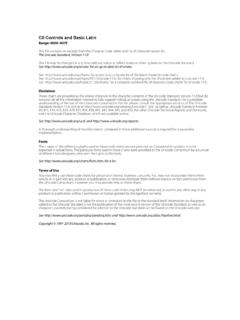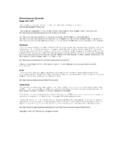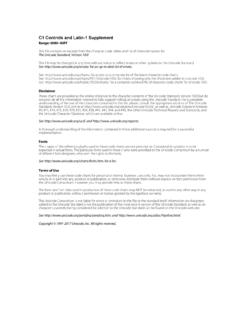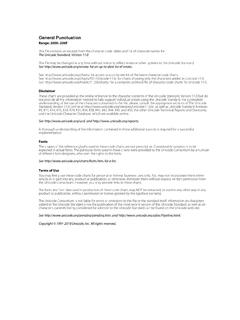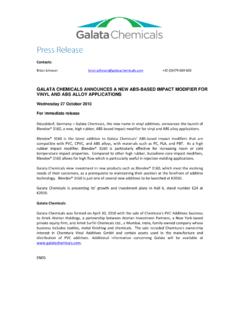Transcription of www.unicode.org
1 Electronic EditionThis file is part of the electronic edition of The Unicode Standard, Version , provided for online access, content searching, and accessibility. It may not be printed. Bookmarks linking to specific chapters or sections of the whole Unicode Standard are available at the BookFor convenient access to the full text of the standard as a useful reference book, we recommend pur-chasing the printed version. The book is available from the Unicode Consortium, the publisher, and booksellers. Purchase of the standard in book format contributes to the ongoing work of the Uni-code Consortium.
2 Details about the book publication and ordering information may be found UnicodeYou or your organization may benefit by joining the Unicode Consortium: for more information, see Joining the Unicode Consortium This PDF file is an excerpt from The Unicode Standard, Version , issued by the Unicode Consortiu-mand published by Addison-Wesley. The material has been modified slightly for this electronic edi-ton, however, the PDF files have not been modified to reflect the corrections found on the Updates and Errata page ( ). For information on more recent versions of the standard, see of the designations used by manufacturers and sellers to distinguish their products are claimed as trademarks.
3 Where those designations appear in this book, and the publisher was aware of a trade-mark claim, the designations have been printed with initial capital letters or in all Unicode Consortium is a registered trademark, and Unicode is a trademark of Unicode, Inc. The Unicode logo is a trademark of Unicode, Inc., and may be registered in some authors and publisher have taken care in the preparation of this book, but make no expressed or implied warranty of any kind and assume no responsibility for errors or omissions. No liability is assumed for incidental or consequential damages in connection with or arising out of the use of the information or programs contained Unicode Character Database and other files are provided as-is by Unicode , Inc.
4 No claims are made as to fitness for any particular purpose. No warranties of any kind are expressed or implied. The recipient agrees to determine applicability of information provided. Dai Kan-Wa Jiten, used as the source of reference Kanji codes, was written by Tetsuji Morohashi and published by Taishukan and CD-ROM label design: Steve Mehallo, publisher offers excellent discounts on this book when ordered in quantity for bulk purchases or special sales, which may include electronic versions and/or custom covers and content particular to your business, training goals, marketing focus, and branding interests.
5 For more information, please contact Corporate and Government Sales, (800) 382-3419, For sales outside the United States please contact International Sales, us on the Web: of Congress Cataloging-in-Publication DataThe Unicode Standard / the Unicode Consortium ; edited by Julie D. Allen .. [et al.]. Version p. cm. Includes bibliographical references and index. ISBN 0-321-48091-0 (hardcover : alk. paper) 1. Unicode (Computer character set) I. Allen, Julie D. II. Unicode Consortium. 2007 '22 dc22 2006023526 Copyright 1991 2007 Unicode, rights reserved.
6 Printed in the United States of America. This publication is protected by copy-right, and permission must be obtained from the publisher prior to any prohibited reproduction, storage in a retrieval system, or transmission in any form or by any means, electronic, mechanical, photocopying, recording, or likewise. For information regarding permissions, write to Pearson Edu-cation, Inc., Rights and Contracts Department, 75 Arlington Street, Suite 300, Boston, MA 02116. Fax: (617) 848-7047 ISBN 0-321-48091-0 Text printed in the United States on recycled paper at Courier in Westford, printing, October 2006 Chapter 7 European Alphabetic Scripts7 Modern European alphabetic scripts are derived from or influenced by the Greek script, which itself was an adaptation of the Phoenician alphabet.
7 A Greek innovation was writing the letters from left to right, which is the writing direction for all the scripts derived from or inspired by Greek. The European alphabetic scripts and additional characters described in this chapter areLatinCy rillicGeorgianGreekGlagoliticModifier lettersCopticArmenianCombining marksThe European scripts are all written from left to right. Many have separate lowercase and uppercase forms of the alphabet. Spaces are used to separate words. Accents and diacritical marks are used to indicate phonetic features and to extend the use of base scripts to addi-tional languages.
8 Some of these modification marks have evolved into small free-standing signs that can be treated as characters in their own Latin script is used to write or transliterate texts in a wide variety of languages. The International Phonetic Alphabet (IPA) is an extension of the Latin alphabet, enabling it to represent the phonetics of all languages. Other Latin phonetic extensions are used for the Uralic Phonetic Latin alphabet is derived from the alphabet used by the Etruscans, who had adopted a Western variant of the classical Greek alphabet (Section , Old Italic).
9 Originally it con-tained only 24 capital letters. The modern Latin alphabet as it is found in the Basic Latin block owes its appearance to innovations of scribes during the Middle Ages and practices of the early Renaissance printers. The Cyrillic script was developed in the ninth century and is also based on Greek. Like Latin, Cyrillic is used to write or transliterate texts in many languages. The Georgian and Armenian scripts were devised in the fifth century and are influenced by Greek. Modern Georgian does not have separate uppercase and lowercase Coptic script was the last stage in the development of Egyptian writing.
10 It represented the adaptation of the Greek alphabet to writing Egyptian, with the retention of forms from Demotic for sounds not adequately represented by Greek letters. Although primarily used The Unicode Standard Electronic editionCopyright 1991 2007 Unicode, Alphabetic Scriptsin Egypt from the fourth to the tenth century, it is described in this chapter because of its close relationship to the Greek is an early Slavic script related in some ways to both the Greek and the Cyrillic scripts. It was widely used in the Balkans but gradually died out, surviving the longest in Croatia.
